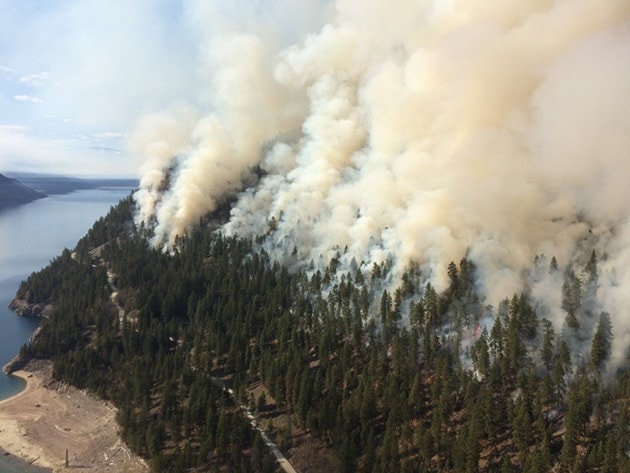It’s been a quiet summer in terms of B.C. wildfires.
With all the rain there’s been 66 wildfires and 321 hectares burnt throughout the Southeast Fire Centre - those numbers are less than half the average for this time of year.
That’s the good news. The less positive point is that of those 66 fires, only 30 were caused by Mother Nature - the other 36 were caused by people.
So with no campfire ban in BC Parks this long weekend, the fire centre’s Karlie Shaughnessy is reminding the public about campfire rules - beginning with the message about keeping a close eye on the flames.
“We want to let everyone know that campfires are allowed as long as they are under half a metre wide and under half a metre high,” says Shaughnessy. “And never leave it unattended. Make sure when you do leave the area, that’s it cold to the touch.”
After last summer’s major wildfire season, 1,340 fires were reported and 290,000 hectares burned by July 30, the province isn’t fooling around when it comes to ticketing those who do not comply with campfire regulations.
The fine for leaving a fire unattended has tripled from $345 in 2015 to $1,150 this year .
“We have fire wardens that do patrol, we also work with C and E (Conservation and Enforcement) and different agencies (for enforcement),” added Shaughnessy.
Though campfires are permitted, open burning and incendiaries like fireworks, remain prohibited.
“Setting of fireworks is considered to be a high-risk activity since they can easily ignite forest fuels and start a wildfire that could threaten public safety,” warns the BC Wildfire Service. “These prohibitions cover all BC Parks, Crown land and private lands.”
Areas within the boundaries of local government that are serviced by a fire department, are subject to respective municipal bylaws.
The rules are cut and dried in Trail - no burning of any kind is allowed, on any day of the year.
But Fruitvale, Montrose Warfield and Rossland do permit small backyard fires under the same regulations as the fire centre. Additionally, those municipalities follow the district’s standing prohibitions, meaning no fireworks or incendiaries are currently permitted.
Like most of the province, wildfire activity around Greater Trail has been very low to date.
Deputy Fire Chief Dan Derby says a number of local firefighters were called out to suspected lightning strikes in the last 24 hours, but other than a spot fire sparked near Midway, no action was required.
He reminds homeowners that with hot weather expected to heat up the region on Thursday, now is the opportune time to put prevention tactics in place.
PreparedBC’s FireSmart program whittles the do’s and don’t of protecting homes into nine easy steps.
Removing leaves from eaves, enclosing soffits, avoid planting highly combustible trees like pine and spruce, stacking firewood and storing propane tanks more than 10 metres from residence, are a few way to protect against wildfire.
PreparedBC practical guides for emergency planning are now available for all households (homes, apartments, condominiums) at the regional fire centre in Trail and at all local municipal offices. All informational booklets are available on the Regional District of Kootenay Boundary website under the “Hot Topics” link. (www.rdkb.com-HotTopics-EmergencyPreparedness.aspx) or on the government’s website, gov.bc.ca.
Based at the Castlegar municipal airport, the Southeast Fire Centre extends from the U.S. border to Mica Dam and from the Okanagan Highlands/west side of the Monashee Mountains to the B.C./Alberta border. Within this area are several provincial parks including Valhalla, Kokanee Glacier, Top of the World and Elk Lakes.
When the attack crews aren’t putting out fires, they are at various sites either training or working with agencies on fuel modification projects to reduce the risk of wildfires.

Above: A 45-hectare ecosystem restoration burn the Southeast Fire Centre undertook in April at Syringa Provincial Park. Shaughnessy notes that historically grasslands and open forest canopy have been maintained in the West Kootenay Region through frequent low-intensity ground fires. The objective of the controlled burn is to rejuvenate the shrub, herb and grass layer, which will restor winter habitat for the mule deer, elk and bighorn sheep, and improve overall biodiversity, create a more open forest and increase the availability of nutrients. (Below: the results of the controlled burn)

“We are never idle,”<span class="Apple-converted-spa
